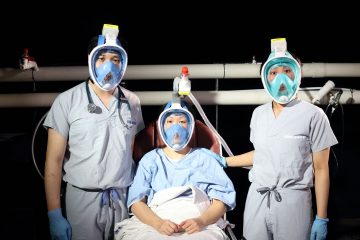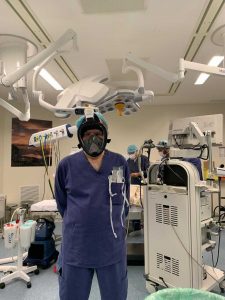BY: Wan Xian (Kate) Koh, UBC MD Class of 2021

Snorkel mask members: Justin Chan, Louise Chen, Kate Koh (right to left), Credits to Lydia Nagai Photography
On March 11th, 2020, the Coronavirus Disease (COVID-19) was declared a pandemic by the World Health Organization (WHO). Medical students from across Canada were pulled from clinical duties. As a 3rd year clerk who had previously been spending 12 hours a day in the hospital, I was suddenly left with a lot of free time and very little direction.
In the days following the WHO announcement, our country and world changed rapidly. There was chaos and confusion, but there was also creativity and innovation. I was given the opportunity to be a part of the Collective Open Source Medical Innovations for COVID-19 (COSMIC) endeavour through which I had the privilege of working with a group of inspirational individuals in the fight against this pandemic.
COSMIC started out as a local initiative based in Vancouver. It was founded by Dr. Christopher Nguan, a kidney transplant urologist at Vancouver General Hospital, Dr. Philip Edgcumbe, a UBC radiology resident and biomedical engineer, and Alexander Waslen, a UBC mechanical engineering student. Since the launch of COSMIC in March 2020, this endeavor, which started with just 10 people meeting on Zoom, has grown to encompass over 100 volunteers, including doctors, engineers, lawyers, entrepreneurs, regulatory experts, designers, artists, videographers, residents and students across various fields.
Our goal is to design and build respiratory support equipment for use in an emergency situation. We had a number of projects ranging from low cost ventilators to emergency respirators. The gravity ventilator, or gVent, is a novel ventilator that provides pressure controlled ventilation through a simple and easily reproducible design involving the use of gravity, water and an inverted piston. Another project, called the clinical respiratory support system (CRS), was designed for use in a field hospital to provide respiratory support and viral containment simultaneously to large numbers of patients. Bubble helmets and modified snorkel masks were designed, modified and tested to provide non-invasive positive pressure ventilation to patients while mitigating the spread of aerosolized viral particles.

Kate Koh, author
As the leader for Project Snorkel Mask, I oversaw the design, testing, and dissemination of our work. The idea of modifying snorkel masks for use during the COVID-19 pandemic first came out of Italy.1 A commercially available, full face snorkel mask can be modified by 3D printing an adapter for the top outlet. Depending on the design of the outlet, the snorkel mask can be retrofitted for use as either PPE or as an interface for non-invasive ventilation that mimics conventional continuous positive airway pressure (CPAP) technology.
Prototyping was only the first step in our endeavour. Once designs were created, they needed to be tested and evaluated for safety and efficacy. These include pressure and flow testing on a dummy head as well as quantitative fit testing to ascertain the seal of the mask and to identify sources of leaks. Leaks have the ability to compromise these face masks and increase the risk of infection among healthcare providers. A local hospital also donated their space for us to test these masks in a simulated patient airway emergency. As self-contamination and infection among providers often occur during doffing of PPE, we designed the simulation trial to assess provider comfort and to receive feedback on ease of use.

Dr. Nigri using our snorkel mask design to treat patients at a hospital in Brazil.
While our initial goal was to supply local hospitals with emergency equipment, we were able to expand our reach by working with collaborators from Vancouver Island, Montreal, India, and Brazil. We pooled our resources together for a common goal. In reality, our work was only made possible because the original innovators in Italy had made their designs open sourced, allowing anyone around the world to access the 3D printed model file. By doing so, others are able to use, improve and redesign it as they see fit. All of COSMIC’s designs will also be open source and made available on the public domain.
While COVID-19 is a difficult time filled with fear, uncertainty, racism and hate, it is also a time when communities can unite towards a common goal. I felt that support and collaborative efforts through my role as project leader. I worked with members I had only met on Zoom from all walks of life and all areas of expertise. We had doctors balance clinical duties with our venture, we had lawyers providing pro bono consultation, we had manufacturers aid with the prototyping process. Our efforts would not be possible without the generosity of so many.
As I complete my final year of medical school, I will carry with me the lessons learned during my time with COSMIC. It was a unique experience to be able to look at medicine from a different perspective. Especially during this era of COVID-19, innovation in medicine cannot be overstated. It is with such innovation that we were able to progress from the gigantic “iron lung” ventilators of the 1950s to the sophistication of modern day mechanical ventilation. It is with such innovation that we are able to use tablets to allow family members to bid farewell to their loved ones dying from COVID-19 in the intensive care unit while respecting isolation precautions. It is important for doctors to challenge the status quo in order to continue to improve patient care.
References
- Isinnova [Internet]. Italy:Isinnova; 2020 [cited 2020 Sept]. Available from: https://www.isinnova.it/easy-covid19-eng/